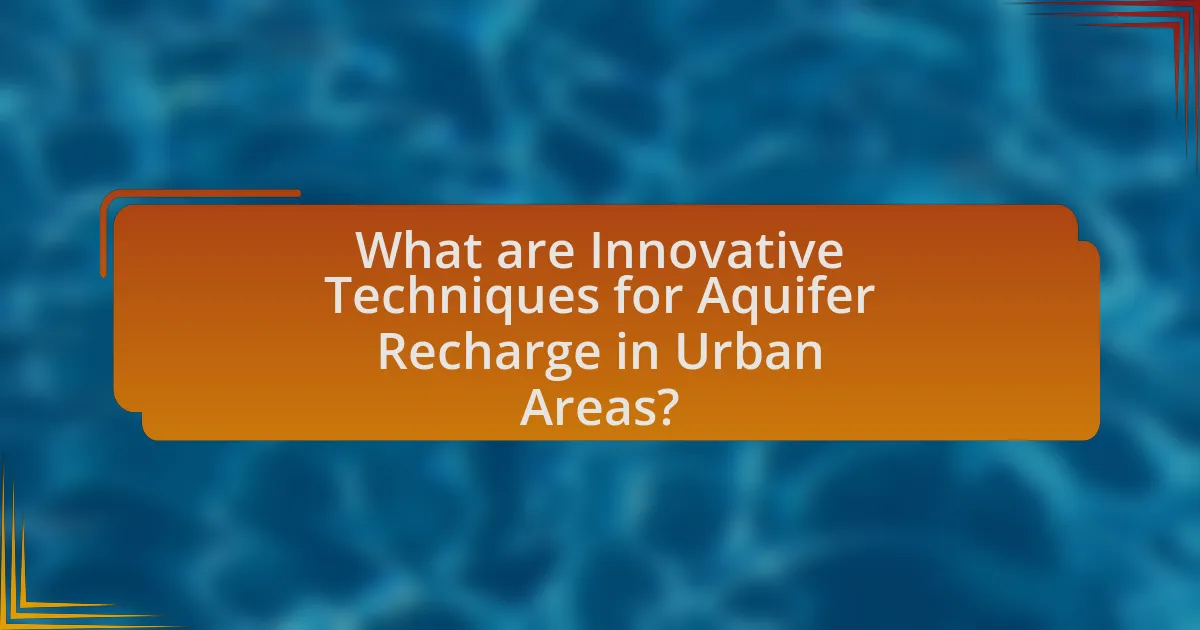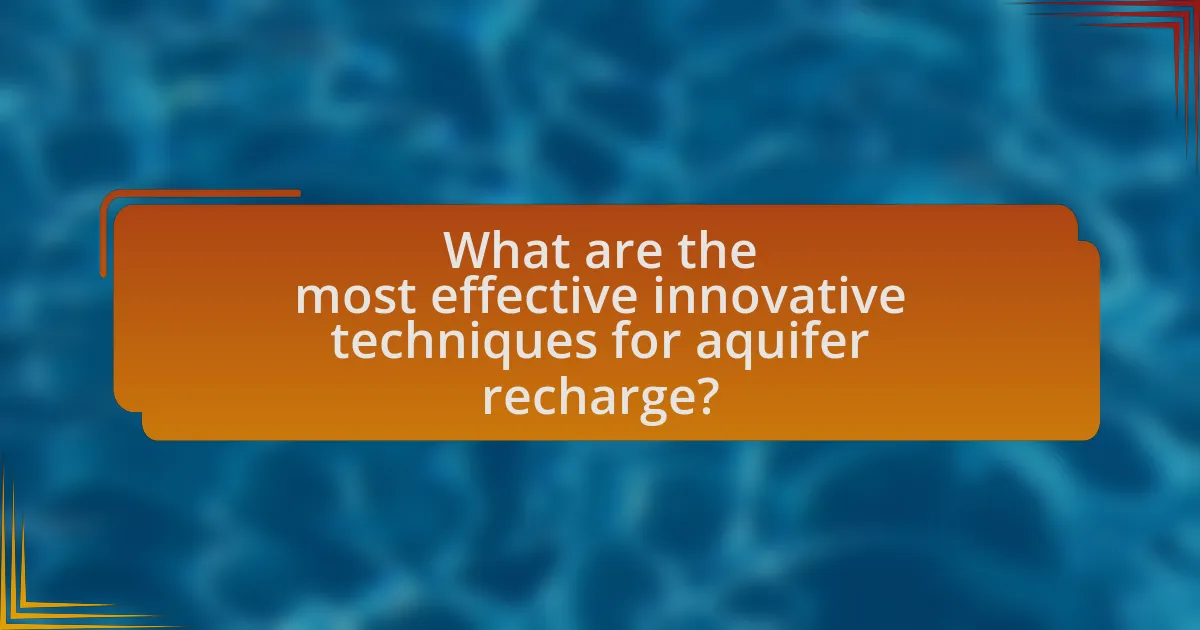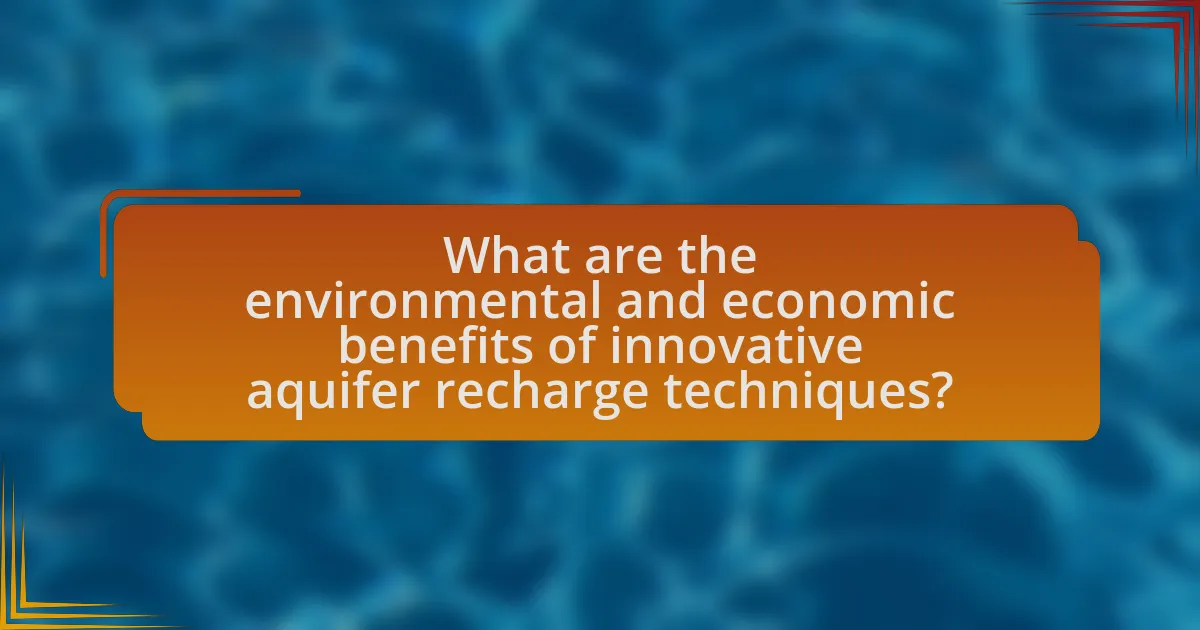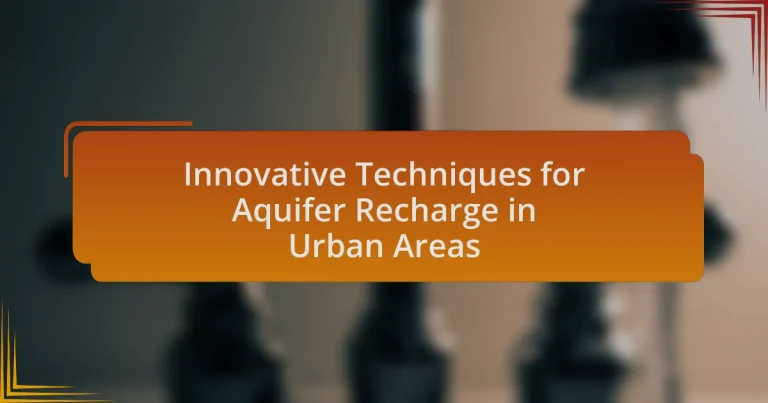Innovative techniques for aquifer recharge in urban areas focus on enhancing groundwater levels through methods such as green infrastructure, managed aquifer recharge (MAR), rainwater harvesting, and permeable pavements. These techniques differ from traditional methods by utilizing advanced technologies and integrating stormwater management to optimize water resource use. Key characteristics include adaptability, efficiency, and sustainability, addressing challenges posed by urbanization, such as impervious surfaces and water contamination. The article also highlights the environmental and economic benefits of these techniques, including improved water quality, reduced flooding costs, and potential job creation, while emphasizing the importance of stakeholder collaboration and effective monitoring for successful implementation.
What are Innovative Techniques for Aquifer Recharge in Urban Areas?

Innovative techniques for aquifer recharge in urban areas include the use of green infrastructure, such as permeable pavements, green roofs, and rain gardens. These methods enhance water infiltration and reduce surface runoff, allowing rainwater to recharge aquifers effectively. For instance, permeable pavements can absorb rainwater, which then percolates into the ground, replenishing groundwater supplies. Studies have shown that implementing green roofs can reduce stormwater runoff by up to 65%, significantly contributing to aquifer recharge. Additionally, managed aquifer recharge (MAR) systems, which involve the intentional recharge of aquifers through surface water, are increasingly being utilized in urban settings to enhance groundwater levels sustainably.
How do these techniques differ from traditional aquifer recharge methods?
Innovative techniques for aquifer recharge in urban areas differ from traditional methods primarily in their approach and efficiency. Traditional aquifer recharge methods often rely on surface infiltration basins or direct injection wells, which can be limited by land availability and the need for extensive infrastructure. In contrast, innovative techniques utilize advanced technologies such as managed aquifer recharge (MAR), which integrates stormwater management and water recycling, allowing for more effective use of urban runoff and treated wastewater. For example, MAR systems can enhance recharge rates by optimizing water quality and reducing evaporation losses, making them more suitable for densely populated areas. This adaptability to urban environments is supported by studies showing that MAR can increase groundwater levels significantly compared to conventional methods, thereby improving water sustainability in cities.
What are the key characteristics of innovative techniques?
Key characteristics of innovative techniques include adaptability, efficiency, sustainability, and integration with existing systems. Adaptability allows these techniques to be customized for various urban environments, ensuring they meet specific local needs. Efficiency is demonstrated through optimized resource use, maximizing water capture and minimizing waste. Sustainability focuses on long-term viability, ensuring that techniques do not deplete resources or harm ecosystems. Integration with existing systems enhances functionality, allowing innovative techniques to work alongside current infrastructure, thereby improving overall urban water management.
Why is innovation necessary in urban aquifer recharge?
Innovation is necessary in urban aquifer recharge to enhance water sustainability and address the challenges posed by urbanization. Urban areas face increased water demand and reduced natural recharge due to impervious surfaces, making traditional methods insufficient. Innovative techniques, such as managed aquifer recharge and the use of green infrastructure, can improve water quality, increase recharge rates, and optimize water resource management. For instance, a study by the U.S. Geological Survey highlights that implementing innovative recharge methods can significantly mitigate flooding and improve groundwater levels in densely populated regions.
What challenges do urban areas face regarding aquifer recharge?
Urban areas face significant challenges regarding aquifer recharge, primarily due to impervious surfaces that prevent water infiltration. The prevalence of concrete and asphalt in cities leads to increased runoff and reduced natural groundwater replenishment. Additionally, urbanization often results in the contamination of stormwater, which can hinder the quality of water that reaches aquifers. According to the U.S. Geological Survey, urban development can decrease groundwater recharge rates by up to 50% compared to natural landscapes. Furthermore, competing land uses and regulatory barriers can limit the implementation of effective recharge techniques, making it difficult to restore aquifer levels in densely populated regions.
How does urbanization impact natural aquifer recharge processes?
Urbanization significantly reduces natural aquifer recharge processes by increasing impervious surfaces, which prevent water infiltration into the ground. As cities expand, the construction of roads, buildings, and other infrastructure leads to a decrease in permeable land, resulting in higher surface runoff and reduced groundwater replenishment. Studies indicate that urban areas can experience a 50-90% reduction in natural recharge rates compared to rural settings, as evidenced by research published in the journal “Water Resources Research,” which highlights the correlation between urbanization and diminished aquifer recharge capacity.
What are the common barriers to implementing innovative techniques?
Common barriers to implementing innovative techniques for aquifer recharge in urban areas include regulatory constraints, funding limitations, and public acceptance issues. Regulatory constraints often arise from existing water management policies that may not accommodate new methods, hindering innovation. Funding limitations can restrict the development and deployment of innovative techniques, as many projects require significant financial investment for research, infrastructure, and maintenance. Public acceptance issues stem from a lack of awareness or understanding of the benefits of aquifer recharge techniques, leading to resistance from communities. These barriers collectively impede the adoption of effective solutions for sustainable water management in urban settings.
What are the most effective innovative techniques for aquifer recharge?

The most effective innovative techniques for aquifer recharge include managed aquifer recharge (MAR), rainwater harvesting, and the use of permeable pavements. Managed aquifer recharge involves the intentional infiltration of water into aquifers through various methods such as recharge basins or injection wells, which can significantly enhance groundwater levels. Rainwater harvesting captures and stores rainwater for later use, allowing for direct infiltration into aquifers, thus reducing surface runoff and promoting groundwater replenishment. Permeable pavements facilitate the infiltration of rainwater into the ground, allowing it to recharge aquifers while also managing stormwater effectively. These techniques have been validated by studies showing their effectiveness in increasing groundwater levels and improving water quality in urban settings.
How does rainwater harvesting contribute to aquifer recharge?
Rainwater harvesting significantly contributes to aquifer recharge by capturing and directing rainwater into the ground, allowing it to percolate through soil layers and replenish underground water sources. This method reduces surface runoff, which can lead to erosion and pollution, while simultaneously enhancing groundwater levels. Studies indicate that implementing rainwater harvesting systems can increase aquifer recharge rates by up to 30%, depending on local conditions and system design.
What systems are used for rainwater harvesting in urban settings?
Rainwater harvesting systems in urban settings primarily include rooftop collection systems, surface runoff collection systems, and underground storage tanks. Rooftop collection systems utilize gutters and downspouts to channel rainwater from building roofs into storage tanks, effectively capturing a significant portion of precipitation. Surface runoff collection systems involve the use of permeable pavements and bioswales to direct rainwater into designated areas for absorption and storage. Underground storage tanks are often integrated into urban infrastructure to store harvested rainwater for later use, such as irrigation or non-potable applications. These systems are essential for managing stormwater, reducing urban flooding, and promoting sustainable water use in cities.
What are the benefits of rainwater harvesting for aquifer recharge?
Rainwater harvesting significantly benefits aquifer recharge by enhancing groundwater levels and improving water quality. This technique captures and stores rainwater, allowing it to percolate into the ground, which replenishes aquifers. Studies indicate that rainwater harvesting can increase groundwater recharge rates by up to 50%, depending on local conditions and implementation methods. Additionally, it reduces surface runoff, which can lead to erosion and pollution, thereby improving the overall quality of water entering aquifers.
What role do permeable pavements play in aquifer recharge?
Permeable pavements facilitate aquifer recharge by allowing water to infiltrate through their surface, directly replenishing groundwater supplies. This infiltration process reduces surface runoff, which can lead to erosion and water quality issues, while simultaneously promoting the natural filtration of pollutants. Studies indicate that permeable pavements can increase groundwater recharge rates significantly, with some research showing that they can enhance recharge by up to 50% compared to traditional impervious surfaces.
How do permeable pavements function to enhance recharge?
Permeable pavements enhance recharge by allowing water to infiltrate through their surface and into the underlying soil and aquifer. This infiltration process reduces surface runoff, promotes groundwater replenishment, and mitigates flooding. Studies have shown that permeable pavements can significantly increase the volume of water that recharges aquifers, with some systems achieving recharge rates comparable to natural landscapes. For instance, research indicates that permeable pavements can facilitate up to 80% of rainfall infiltration, effectively supporting urban water management and sustainability efforts.
What are the maintenance requirements for permeable pavements?
Permeable pavements require regular maintenance to ensure their functionality and longevity. This maintenance includes routine inspections to identify sediment buildup, which can clog the surface and impede water infiltration. Additionally, periodic cleaning using vacuum sweepers or pressure washing is necessary to remove debris and restore permeability. It is also important to replenish the aggregate material in the joints as it may wash away over time, ensuring that the pavement continues to facilitate water drainage effectively. Regular maintenance helps maintain the structural integrity of permeable pavements and supports their role in aquifer recharge by allowing rainwater to infiltrate the ground.
How can green roofs facilitate aquifer recharge?
Green roofs facilitate aquifer recharge by capturing and retaining rainwater, which reduces surface runoff and allows for gradual infiltration into the soil. This process enhances groundwater levels, as the vegetation and substrate on green roofs absorb precipitation, slowing its release and promoting percolation through the layers of soil. Studies indicate that green roofs can retain up to 80% of rainfall, significantly contributing to local aquifer replenishment.
What are the design considerations for green roofs aimed at recharge?
Design considerations for green roofs aimed at recharge include selecting appropriate vegetation, ensuring adequate substrate depth, and incorporating drainage systems that facilitate water retention and infiltration. The choice of vegetation should prioritize native species that require minimal irrigation and can thrive in the local climate, which enhances the roof’s ability to absorb rainwater. Substrate depth is critical; a minimum of 10 to 15 centimeters is often recommended to support plant growth and maximize water retention. Additionally, integrating a drainage layer with perforations allows excess water to percolate down to the underlying layers, promoting aquifer recharge. Research indicates that well-designed green roofs can reduce stormwater runoff by up to 75%, thereby contributing significantly to groundwater replenishment.
How do green roofs impact urban water management?
Green roofs significantly enhance urban water management by reducing stormwater runoff and improving water quality. They achieve this by absorbing rainfall, which mitigates the volume of water that enters drainage systems during heavy rain events. Studies indicate that green roofs can retain up to 75% of rainfall, depending on the design and vegetation used. This retention not only decreases the risk of urban flooding but also filters pollutants from rainwater, leading to cleaner water entering local waterways. Additionally, the presence of green roofs contributes to the cooling of urban areas, which can further reduce the demand for stormwater management infrastructure.
What are the environmental and economic benefits of innovative aquifer recharge techniques?

Innovative aquifer recharge techniques provide significant environmental and economic benefits. Environmentally, these techniques enhance groundwater levels, improve water quality by filtering pollutants, and support ecosystems by maintaining base flows in rivers and wetlands. Economically, they reduce the costs associated with water supply and treatment, mitigate flood risks, and increase property values by ensuring sustainable water resources. For instance, a study by the U.S. Geological Survey found that managed aquifer recharge can lead to a 30% reduction in water supply costs for municipalities, demonstrating both the financial and ecological advantages of these innovative methods.
How do these techniques improve urban water quality?
Innovative techniques for aquifer recharge in urban areas improve urban water quality by enhancing the natural filtration processes and increasing the availability of clean groundwater. These techniques, such as managed aquifer recharge and green infrastructure, facilitate the infiltration of surface water into aquifers, which helps to dilute contaminants and reduce pollutants. For instance, studies have shown that managed aquifer recharge can remove up to 90% of certain contaminants, thereby significantly improving the quality of water that re-enters the urban water supply system. Additionally, these methods promote the sustainable use of water resources, ensuring that urban areas can maintain a reliable supply of high-quality water while mitigating the impacts of urban runoff and pollution.
What specific pollutants can be mitigated through aquifer recharge?
Aquifer recharge can mitigate specific pollutants such as nitrates, heavy metals, and pathogens. Nitrates, commonly found in agricultural runoff, can be reduced through the natural filtration processes during aquifer recharge. Heavy metals, often originating from urban runoff and industrial discharges, can also be attenuated as water percolates through soil and sediment layers. Additionally, pathogens, which may enter groundwater through contaminated surface water, can be effectively removed by the biological and physical processes occurring in the aquifer. Studies have shown that these processes significantly enhance water quality, making aquifer recharge a viable method for pollutant mitigation in urban areas.
How does improved water quality affect public health?
Improved water quality significantly enhances public health by reducing the incidence of waterborne diseases. Access to clean water decreases the risk of illnesses such as cholera, dysentery, and typhoid fever, which are directly linked to contaminated water sources. According to the World Health Organization, improved water quality can lead to a 50% reduction in diarrheal diseases, highlighting the critical role of safe drinking water in promoting health. Furthermore, better water quality supports overall hygiene and sanitation practices, contributing to healthier communities and lower healthcare costs.
What economic advantages do innovative aquifer recharge techniques offer?
Innovative aquifer recharge techniques offer significant economic advantages, including reduced water supply costs and enhanced water security. By utilizing methods such as managed aquifer recharge, cities can store excess surface water during wet periods, which decreases reliance on expensive alternative water sources during droughts. For instance, a study by the U.S. Geological Survey found that cities implementing these techniques can save up to 30% on water supply costs over time. Additionally, these techniques can increase property values by ensuring a stable water supply, which is crucial for urban development and sustainability.
How can these techniques reduce urban flooding costs?
Innovative techniques for aquifer recharge in urban areas can significantly reduce urban flooding costs by enhancing water infiltration and storage capacity. These methods, such as permeable pavements and green roofs, allow rainwater to be absorbed into the ground rather than overwhelming drainage systems. For instance, studies have shown that implementing permeable surfaces can reduce runoff by up to 50%, thereby decreasing the volume of water that needs to be managed during heavy rainfall events. This reduction in runoff leads to lower infrastructure maintenance costs and less frequent flooding, ultimately saving municipalities money on flood management and damage repair.
What is the potential for job creation in implementing these techniques?
The potential for job creation in implementing innovative techniques for aquifer recharge in urban areas is significant. Research indicates that the adoption of these techniques can lead to the creation of various jobs in sectors such as construction, environmental engineering, and water management. For instance, a study by the Water Research Foundation found that green infrastructure projects, which often include aquifer recharge systems, can create approximately 17 jobs per million dollars invested. This demonstrates a clear link between investment in aquifer recharge techniques and job creation, highlighting the economic benefits alongside environmental sustainability.
What best practices should be followed for successful implementation?
Successful implementation of innovative techniques for aquifer recharge in urban areas requires a comprehensive approach that includes stakeholder engagement, site-specific assessments, and adaptive management strategies. Engaging stakeholders, such as local communities and government agencies, ensures that the needs and concerns of all parties are considered, fostering collaboration and support. Conducting site-specific assessments allows for the identification of the most suitable recharge methods based on local hydrology, soil types, and land use, which enhances the effectiveness of the techniques employed. Furthermore, implementing adaptive management strategies enables continuous monitoring and adjustment of practices based on performance data and changing conditions, ensuring long-term sustainability and success.
How can stakeholders collaborate effectively in urban aquifer recharge projects?
Stakeholders can collaborate effectively in urban aquifer recharge projects by establishing clear communication channels and shared objectives. This collaboration involves local governments, water management authorities, community organizations, and private sector partners working together to identify suitable recharge sites, develop sustainable practices, and engage the public in awareness campaigns. For instance, the City of Los Angeles has successfully implemented stakeholder engagement strategies that include public workshops and collaborative planning sessions, resulting in the development of the Sustainable City pLAn, which aims to enhance water resilience through aquifer recharge. This approach not only fosters trust among stakeholders but also ensures that diverse perspectives are considered, leading to more effective and inclusive project outcomes.
What are the key factors for monitoring and evaluating recharge effectiveness?
The key factors for monitoring and evaluating recharge effectiveness include hydrological measurements, water quality assessments, and land use impacts. Hydrological measurements, such as groundwater levels and flow rates, provide essential data on the volume of water recharged and its movement within the aquifer. Water quality assessments ensure that the recharge process does not introduce contaminants, maintaining the safety of the water supply. Additionally, evaluating land use impacts helps identify how urban development affects recharge areas, influencing both the quantity and quality of water entering the aquifer. These factors collectively enable a comprehensive understanding of recharge effectiveness, ensuring sustainable management of urban aquifers.


